20 Volcanoes. 6 Scientists. 1 Mission.
This is the Trail by Fire.
The atmosphere that allows our planet to sustain life formed from gases emitted by volcanoes early in Earth's history. These volatile elements are constantly recycled back into the deep Earth at subduction zones, where tectonic plates sink into the mantle. During this process the sinking plate is subjected to increasing heat and pressure, and releases volatiles. These volatiles, once added to the mantle, induce melting and fuel volcanic explosions, completing the cycle. While this depiction of the earth’s giant recycling factory is well established conceptually, we do not know how efficient it is. We can estimate how much goes in, but have little idea what proportion is released back to the atmosphere, and what proportion remains trapped at depth. This question is crucial if we want to understand how our atmosphere formed and our planet became able to sustain life. In the present-day context, characterizing how much gas comes out of the giant recycling factory is also key to understanding volcanic effects on climate, volcanic emissions being significant - but poorly constrained - parameters in current climate models..
Our team of early career volcanologists is conducting expeditions to the South American Andes. Our objective is to provide the first accurate and large-scale estimate of the flux of volatile species (H2O, H2, CO2, CO, SO2, H2S, HCl, HF, and more) emitted by volcanoes of the Nazca subduction zone. The journey is taking us across half a continent, from the giant volcanoes of Ecuador through the altiplanoes of Peru and to the Southern tip of Chile, traveling on some of the Earth’s highest roads, and climbing some of the Earth's tallest volcanoes.





















